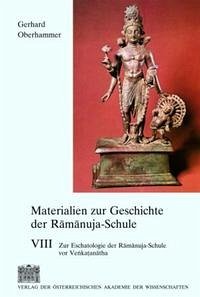The final section deals with the adoption of Rāmānuja’s teaching by later authors of the Rāmānuja School’s Sanskrit tradition, including Nārāyaṇārya and Meghanādārisūri (both probably ca. 1300 CE). Like Rāmānuja, they both argue for union with the Brahma and the brahmanic-vedāntic concept of the "way of the gods" as being the state of salvation after death. In contrast, Varadaguru (13th c. CE) adds an alternative teaching, which is part of a śaraṇāgati theology, according to which he who performs the formal act of devotion (śaraṇāgatiḥ) to Viṣṇu may be sure of the grace and help of God in the hour of his death, thus attaining Viṣṇu directly (not via the "way of the gods").Der achte Teil der „Materialien zur Geschichte der Rāmānuja-Schule“ ist der Lehre der Schule vor Veṅkaṭanātha (14. Jh. n. Chr.) Hingehen des Menschen nach dem Tode zu Brahma und der Vorstellung vom bleibenden Heilszustand des Menschen gewidmet. Der erste Teil der Studie stellt diese Lehre in der bereits voll entwickelten Form dar, die sie gründend auf den autoritativen Aussagen der Upaṇaden von Rāmānuja (11. Jh. n. Chr.) in der Brahmasūtrentradition erhalten hat. Charakteristisch für Rāmānujas Eschatologie ist der Umstand, dass Rāmānuja die mythologisch-konkrete Vorstellung zum Arcirādimārga und dem Dasein des Menschen nach dem Tode zwar auf Grund der Autorität der Upanịaden annimmt, den Heilszustand des Ātmā aber nach dem Modell der mystischen Erfahrung in seinem Wesen „entmythologisiert“ und im Lichte seiner ontotheologischen Reflexion des Ātmā erklärt. Der zweite Teil bringt die Übersetzung und Analyse seines Vaikuṇṭhagadyam, eines in poetischer Sprache verfassten Lehrtextes, in welchem Rāmānuja eine allen Viṣṇu-Verehrern zugängliche Meditation darstellt, in der eine neue Mythisierung des erhofften endgültigen Heilszustands des Menschen begegnet, nämlich die Vorstellung, in Vaikuṇṭha, Viṣṇus Welt der Seligen, für immer Gottes Diener zu sein.
Bitte wählen Sie Ihr Anliegen aus.
Rechnungen
Retourenschein anfordern
Bestellstatus
Storno

